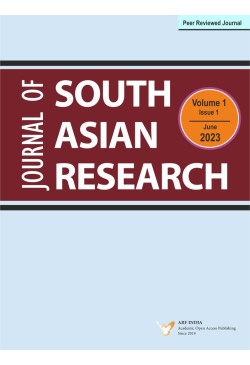
JOURNAL OF SOUTH ASIAN RESEARCH
Frequency :Bi-Annual
ISSN :2583-7273
Peer Reviewed Journal
EMPOWERING RURAL DEVELOPMENT THROUGH CONVERGENCE: INTEGRATING VILLAGE POVERTY REDUCTION PLANS WITH GRAM PANCHAYAT DEVELOPMENT PLANS
This research paper explores the critical interface between Gram Panchayats (GPs) and Self Help Groups (SHGs) in rural development and poverty reduction in India. Article 243G of the Constitution empowers GPs with the authority for local planning and implementation of schemes. The Fourteenth Finance Commission grants in 2015 provided GPs with an opportunity for independent development planning. The People’s Plan Campaign (PPC) introduced the Gram Panchayat Development Plan (GPDP), enabling citizens and elected representatives to collaborate in decentralized planning. The paper focuses on integrating Village Poverty Reduction Plans (VPRPs), prepared by SHGs and federations under the Deendayal Antyodaya Yojana-National Rural Livelihoods Mission (DAY-NRLM), with the GPDP. VPRPs allow poor families, through SHGs, to participate and project their demands for local area development. The VPRPs encompass five major components: social inclusion, entitlement, livelihoods, public goods and services, and resource development. Training for State Missions on VPRP is discussed, with ready-to-use tools and a phased approach for effective implementation. This research highlights the potential of convergence between DAY-NRLM and Panchayati Raj Institutions, empowering marginalized communities in their development initiatives. The integration of VPRPs with GPDPs fosters a participatory approach, addressing local development needs and promoting social inclusion, contributing to the holistic transformation of rural India.
Keywords: Rural development, Gram Panchayats, Self Help Groups (SHGs), Village Poverty Reduction Plans (VPRPs), Convergence, Participatory planning
Veeragoni Shirisha & Rajiv Kumar (2023). Empowering Rural Development through Convergence: Integrating Village Poverty Reduction Plans with Gram Panchayat Development Plans, Journal of South Asian Research, 1: 2, pp. 93-110.
MEDITERRANEAN TRADE IN EARLY TAMIL REGION – A STUDY OF THE ARCHAEOLOGICAL EVIDENCE
The trade between early Tamilakam and the Mediterranean region was a significant component of the changes witnessed by the early historic India. The exchange of commodities promoted industrial and urban developments in the Tamil region. Subsequent expansion of the maritime trade networks to Sri Lanka and Southeast Asia not only facilitated economic growth but also promoted cultural interactions. The unevenly distributed resources in diverse physiographic zones necessitated the exchange of commodities for ancient Tamils. The coastal as well as inland centres served as important segments of the trade networks. The present study focuses upon the archaeological remains discovered from recently excavated sites in the Tamil region which add to our information and offer fresh insight into the extension of the Indo-Roman trade.
Keywords: Archaeological; Coins; Excavations; Indo-Roman; Inscrtiptions; Mediterranean; Rouletted Ware; Sangam; Tamil; Trade
Vikas K. Verma (2023). Mediterranean Trade in Early Tamil Region – A Study of the Archaeological Evidence, Journal of South Asian Research, 1: 2, pp. 111-134.
ASSESSING TRENDS IN WOMEN’S REPRODUCTIVE HEALTH AND FAMILY PLANNING IN HARYANA: INSIGHTS FROM NFHS-4 AND NFHS-5
Keywords: fertility rate, reproductive health, family planning, contraceptive prevalence, birth interval, sex preferences.
INVESTIGATION AND ASSESSMENT ON ROLE OF HOSTELS IN SHAPING THE ATTITUDE, ETHICS AND ACADEMIC PERFORMANCE OF HOSTELERS IN THE REGION OF KASHMIR INDIA
THE KOSHER LIFE-THE EXPERIENCES OF INDIAN JEWISH COMMUNITY
Keywords: Ethnicity, Indian Jews, rituals, Dietary laws, Kosher, foods of Indian Jews